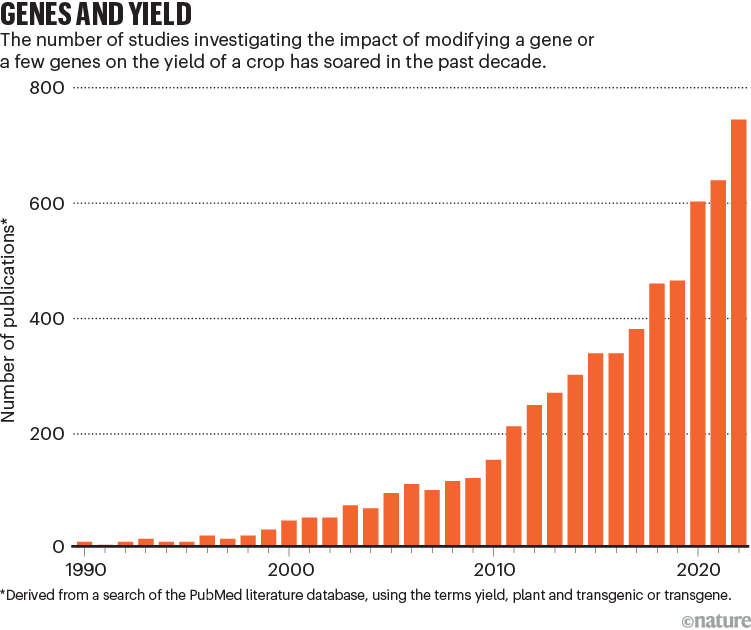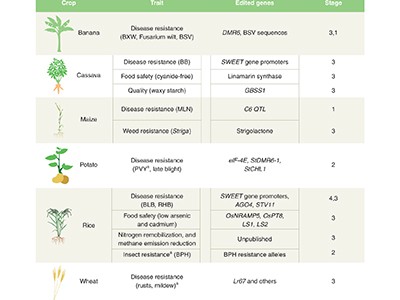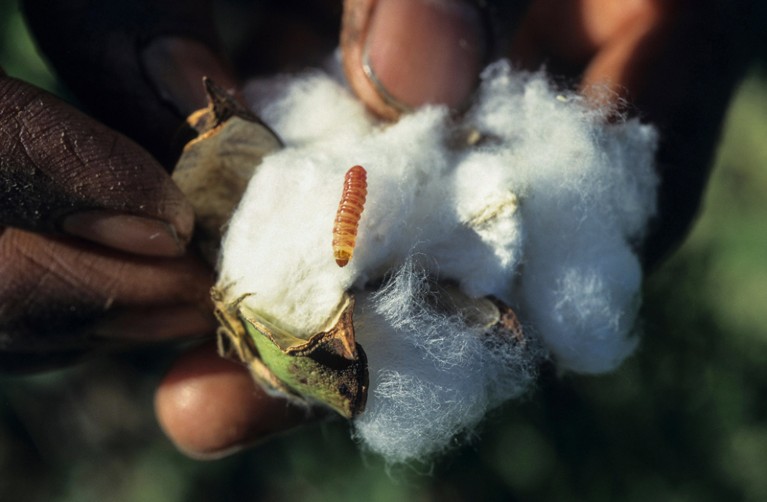Over the past two decades, many journals, including this one, have published papers describing how modifying one or a few genes can result in substantial increases in crop yields (see ‘Genes and yield’). The reported increases range from 10% to 68%, and the crops analysed include rice, maize (corn), tobacco and soya bean1–4.
These studies have contributed important insights in molecular biology and gene discovery. But many are the results of tests conducted in greenhouses or in small-scale field trials — the latter typically involving plants grown in small plots. Few, if any, have used the experimental designs needed to evaluate crop performance in real-world environments. And hardly any findings have translated into yield increases on actual farms.
Especially in the context of climate change and a growing human population, the growth of misleading claims around yields has become a cause of concern to us. As plant breeders, quantitative geneticists, evolutionary biologists and plant biologists, many of us have worked on national projects or on crop breeding in collaboration with multinational companies.

Analysis of PubMed data M. Khaipho-Burch et al.
To encourage more impactful science, we ask researchers, reviewers and journal editors to ensure that at least five criteria are met whenever claims are made about the effects of single genes or a few genes on the yield of a crop. We also urge researchers across our range of disciplines to work together much more than they currently do, and to use well-established yield-testing approaches.
Perspective is needed
Table of Contents
Promising reports of the possible effects on crop yields of introducing a gene from another species, or of using the gene-editing technique CRISPR–Cas9 to modify a gene or multiple genes, attract considerable media attention. Yet, more-conventional plant-breeding approaches used over decades paint a very different picture of what genetic modifications are likely to achieve, in relation to yields, in the coming decades.
What breeders and quantitative geneticists consider true breakthroughs in crop productivity have entailed yield increases of the order of 1–5% in a single generation5–7. These validated increases come from multi-year experiments involving multiple plots and locations around the world. Although seemingly modest, these increases are actually remarkable in the context of total global production.
Take the two-decade long project conducted by the seed company Corteva Agriscience, based in Indianapolis, Indiana, the results of which were published in 2021 in Plant Science. Investigators tested the effect of 1,671 genes, taken from 47 species, on yield, nitrogen use, water use and other traits in maize. Only 1% of these genes (22 genes) increased yield enough in an initial trial to warrant more investigation7. And in subsequent rounds of testing, only one gene — zmm28, which encodes a transcription factor — generated the kind of yield improvements that the company had been hoping for.
To interrogate the effects of zmm28 in the field, researchers introduced genetic changes that result in the overexpression of the gene into two elite inbred lines. (Intense selection over the past 100 years has produced maize elite inbred lines, which can be crossed to produce high-yielding hybrids.) These were used to create 48 types of hybrid plant, which were tested over 4 years in 58 location–year combinations worldwide. All this field testing showed that the overexpression of zmm28 could increase the yield of maize by around 2%5.

A farmer in Sunamganj, Bangladesh, moves harvested rice by boat after rains triggered flooding.Credit: Md Manik/SOPA Images/LightRocket via Getty
Thousands of genes affect crop yields indirectly. In maize alone, around 20–30 genes, such as those in the liguleless family, which alter the angle of leaves, have allowed farmers to increase the density of plants on their farms by 3–4 times over the past 100 years or so8. About 8.5–17% of the observed growth in yield can be attributed to a rise in planting density8,9. But yield itself is a highly complex, polygenic trait — meaning that it is controlled by thousands of variants, each with a small effect10.
Although single genes can affect yield, such genes always operate in conjunction with soil and fertilizer management regimes, the hundreds of other genes involved in crop domestication and adaptation, and so on. The drastic increase in crop yields and agricultural production of the Green Revolution, for instance, stemmed from the introduction of the gene variants Rht-B1 and Rht-D1 into wheat and sd1 into rice, in combination with greater use of synthetic fertilizer. These variants shortened the plants, reducing their susceptibility to damage in high winds.
In our view, it is unlikely that more than a handful of genes with major beneficial effects on yield — in the absence of environmental stressors and pathogens — exist. Crop yield has evolved under intense selection, such that any gene variant that significantly increases yield across most of the environments and varieties of a crop in existence today has already been incorporated into breeding lines.
Given all this, it is unsurprising that none of the published studies claiming that a single gene or a few genes affect yield has been validated under conditions resembling those on farms. But why are such claims being published in the first place?

Genome-edited crops for improved food security of smallholder farmers
We think the main reasons are a lack of appropriate expertise being included among research teams, and journal editors not consulting peer reviewers with the appropriate breadth of expertise.
Without plant breeders, quantitative geneticists or agronomists (researchers focused on soils and agricultural practices) in their teams, researchers might fail to ensure that yield assessments are conducted using appropriate experimental designs. Likewise, without enough reviewers and editors familiar with the intricacies of experimental design and statistics used in larger-scale crop trials, problematic claims about yield increases could persist in published papers.
In high-impact, non-specialist journals such as Nature or Science, the problem might stem from editors not having enough contact with specialists in crop breeding and quantitative genetics — scholars who are trained to critically examine field-based experiments and yield trials. Papers in these journals tend to devote just a few sentences to the results of greenhouse experiments or small-scale field trials. The reviewers are more likely to be molecular biologists or geneticists, and to focus most of their attention on the main contribution of a paper — often the molecular-biology changes caused by a genetic improvement.
Five criteria
To evaluate the impact of a genetic change (or multiple changes) on crop productivity, investigators should adhere to testing methods that have worked well for nearly a century11. At a minimum, researchers, reviewers and journal editors should ensure that these five criteria are met.
Studies should use standard definitions of yield. For the world’s seven most-grown crops (maize, wheat, rice, soya bean, cassava, potato and sorghum), farmers and breeders describe yield as either the weight of dry grain harvested per unit area, or the dry-matter content of the roots and tubers harvested per unit area. Researchers reporting changes to yield should use these measures, not some other metric such as grain length or grain width.
Trials should be replicated across plots, geographical locations and years. In some cases, researchers record data from multiple plots in small-scale field studies but then report yields only from the best-performing plots or plants. More commonly, investigators measure yield in unreplicated trials, without considering variable environmental conditions (including future ones predicted by climate modelling), or the harvesting and other practices typical for that crop on real farms.
This might be partly due to the strict regulatory constraints some countries impose on the testing of genetically modified plants, and the high costs associated with testing under such constraints. Yet the impact of genes with hugely variable effects across genotypes and environmental conditions might not be stable enough to be commercially competitive6,7. So it is crucial that researchers design experiments with sufficient statistical power to deal with whatever constraints they face.

A farmer in India holds a cotton boll containing a bollworm, a major pest that destroys cotton fibres.Credit: Joerg Boethling/Alamy
Varieties, planting densities and other conditions should closely match those on farms. As much as possible, researchers should factor into their experimental designs the conditions and practices of the farms that could ultimately produce the crop. This means striving to replicate real-world practices for fertilizer application, tilling, irrigation, sowing, harvesting and so on. It means adopting plot designs that avoid edge effects, which can distort yield estimates, and growing plants at standard densities.
Over the past century, breeders have selected crop variants that tolerate high densities, but in many small-scale trials, plants are spaced at low, commercially irrelevant densities. In fact, yield is sometimes measured from single plants, rather than from whole plots. Yet genotypes that result in a significant increase in yield from individual plants — for instance by making them grow taller than neighbouring ones — could fail to affect the yield of an entire plot when the plants are grown at densities typically used by farmers9.
Lastly, it means using, wherever possible, elite, commercially competitive varieties — not older ones — as comparative standards in field trials. The yields of older varieties can be 4–17 times less than for today’s commercial varieties12,13. Indeed, breeding companies always test the effects of single genes in hundreds of thousands of plants, grown from numerous elite varieties, before they consider commercializing a product that incorporates such a gene14.
Appropriate controls should be used. Measurements of yield in modified crops should be compared with the local or national yield of whatever crop is being investigated, not with some older variety that’s no longer used. The performance of hybrid varieties should be compared with that of other hybrid varieties, not inbred lines, and so on. Controls should also include ‘null constructs’ — plants that carry the molecular improvements accompanying the modification of interest (such as a reporter gene, which signals that the gene of interest has been successfully introduced), but not the key genetic change itself.
Researchers should prioritize genes that plant breeding might have missed. Before investing considerable time and money in conducting research on a particular gene of interest, investigators should check that comparable alleles are not already present or fixed in commercial crop varieties. If plant breeders have already worked with a gene for decades, it is extremely unlikely that it will suddenly deliver major yield gains.
A better path
In commercial plant-breeding programmes, researchers use clearly defined testing phases to reliably turn discoveries into products. The same thing happens in drug development. Just as consistent criteria are used in clinical-trial registries and molecular-assay reporting15, plant scientists should develop criteria to define minimum standards for yield testing at each stage.
Certainly, more collaboration between molecular biologists, plant breeders, agronomists and quantitative geneticists would help to ensure that all the steps we outline here are taken when assessing the impact of a genetic modification on yield (see ‘Genomic selection’).
Yet we’ve been surprised by the number of molecular biologists and other researchers who are unaware of the number of publicly funded organizations conducting field trials that could help them with testing. Every year, for instance, the publicly funded Genomes to Fields Initiative in the United States tests maize varieties in 30 locations across the country in rigorous yield trials16. Internationally, university-based breeding programmes run field trials at the scale of farms, and crop-innovation centres, such as those run by the international partnership known as the Consultative Group on International Agricultural Research (CGIAR), lead large-scale field trials that test crop varieties all over the world. With sufficient support, even for-profit organizations will be motivated to test the impact of a researcher’s ‘gene of interest’.
Today, maize, rice, wheat and soya bean together provide two-thirds of the world’s agricultural calories. Yet the rates of yield improvement in these crops are not enough to match anticipated demand, owing to climate change and a growing population17. Against such enormous challenges around global food security, we urge researchers to adopt tried-and-tested methods to accurately measure the impact of genetic changes on crop yields.
